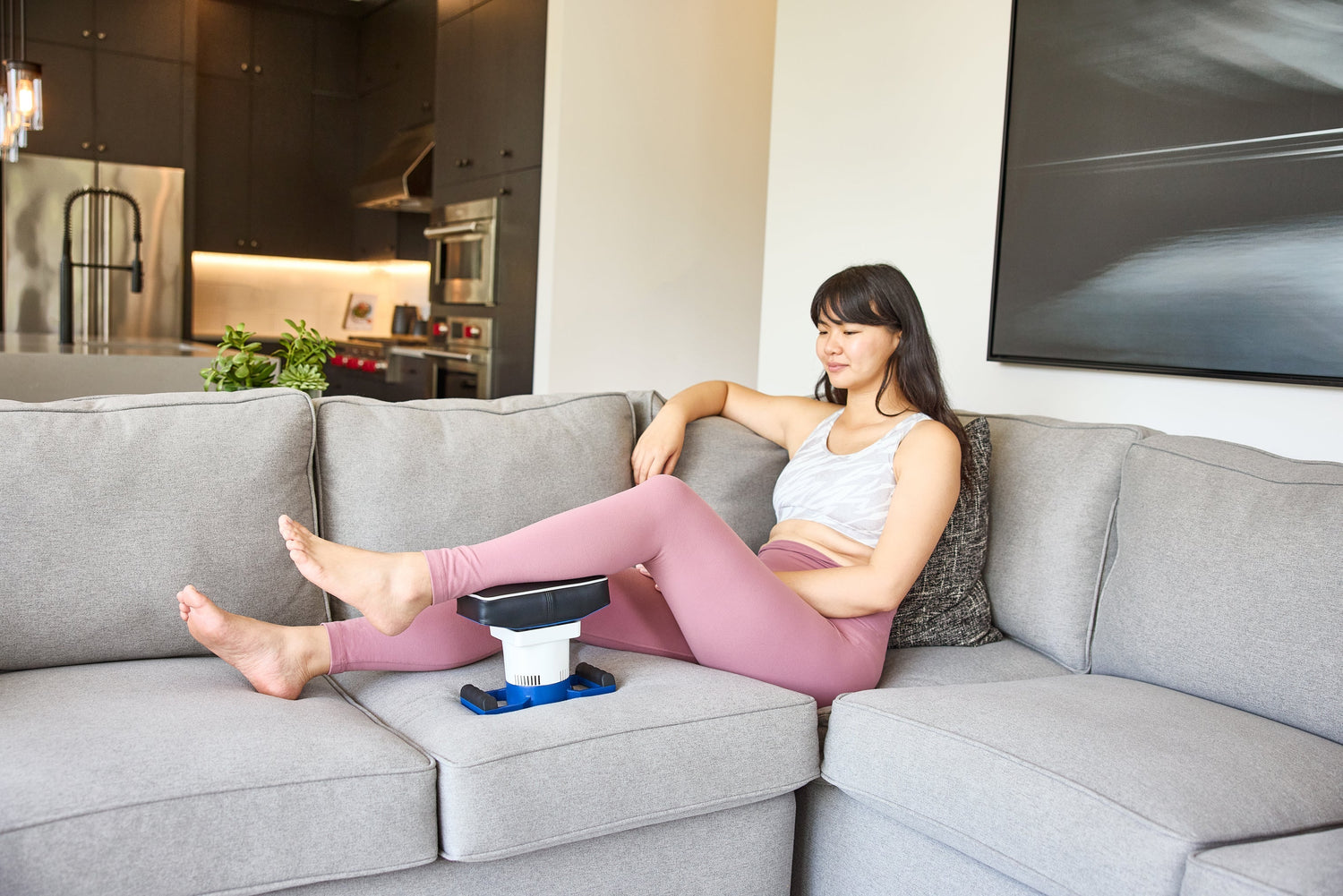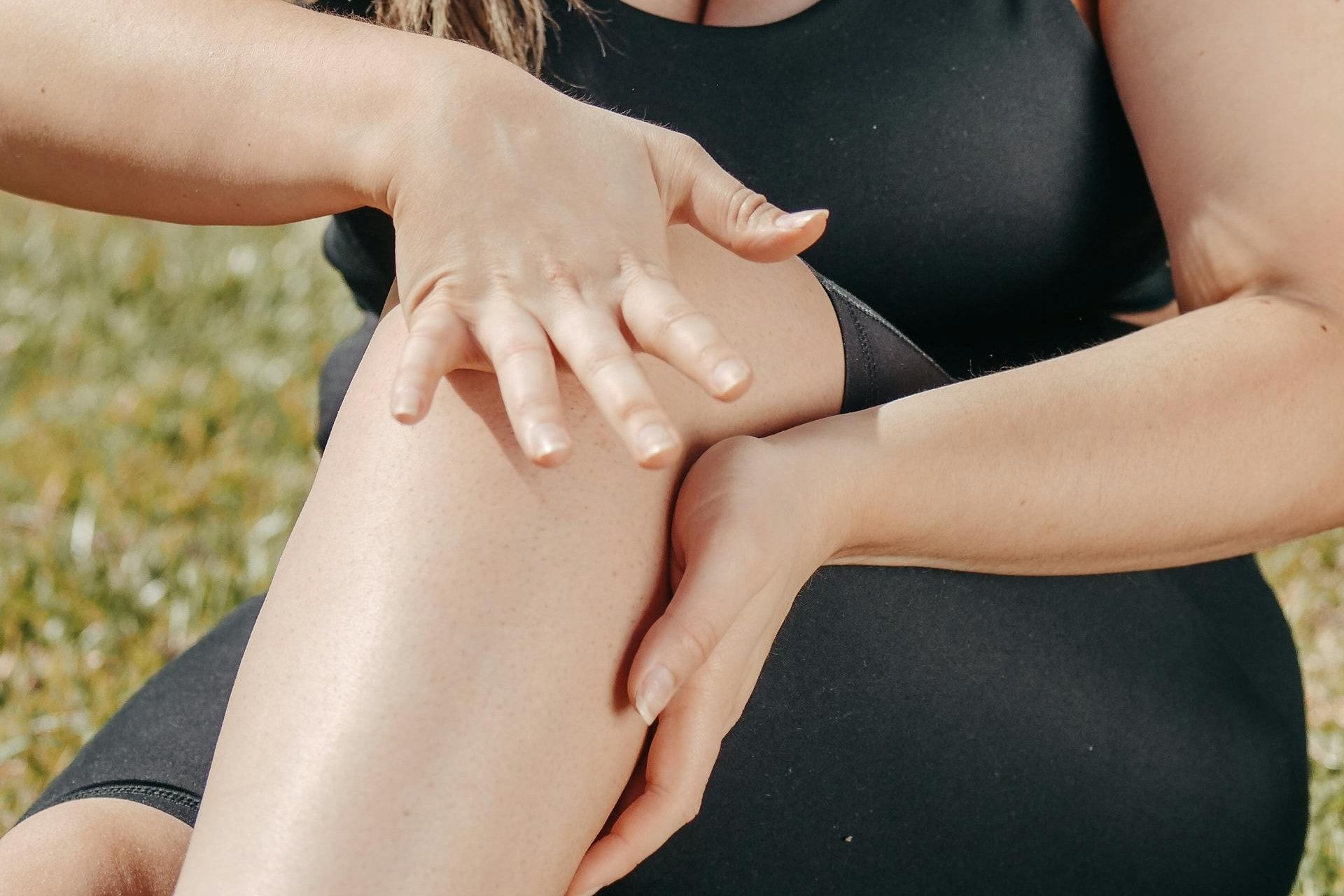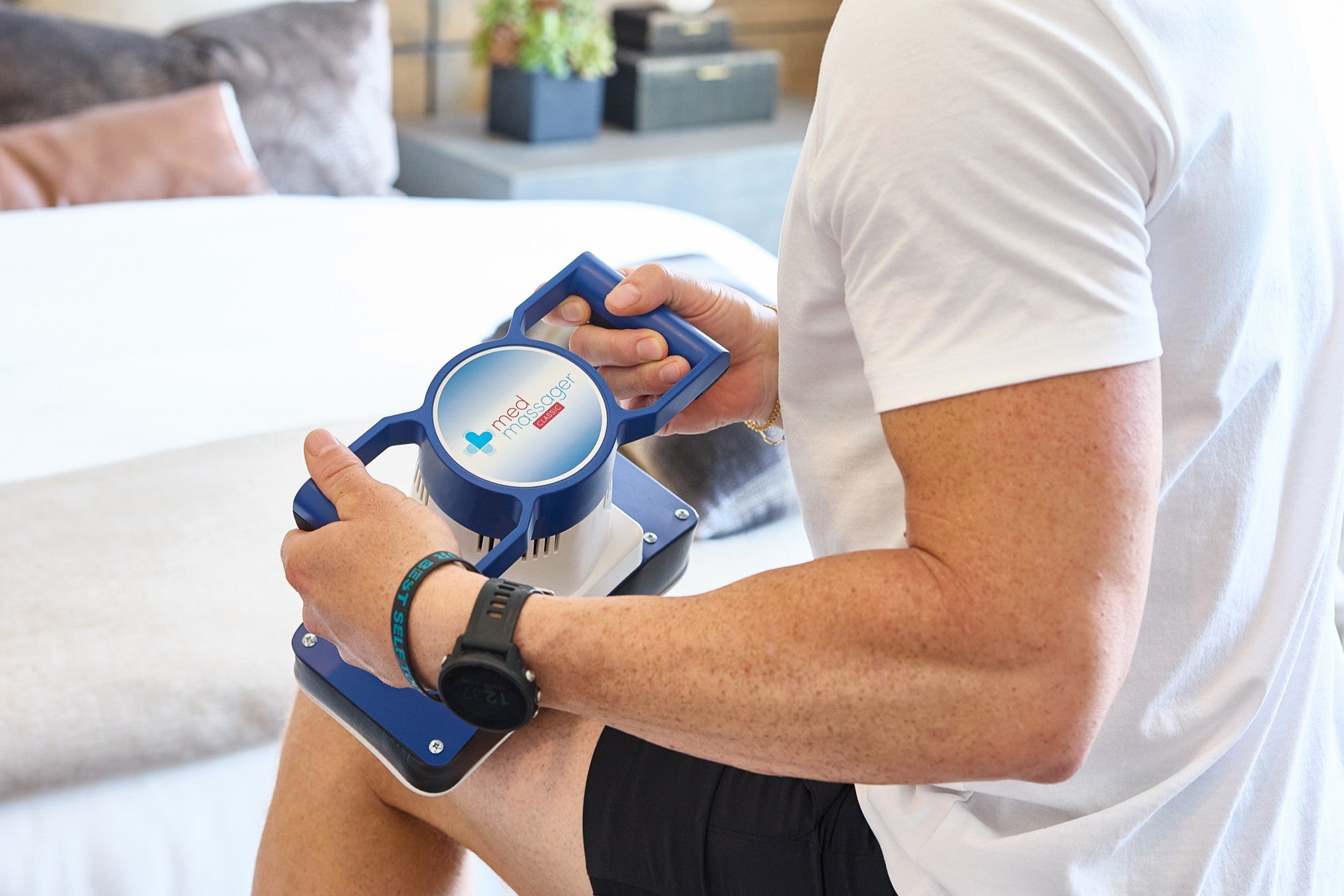Partie la plus volumineuse du mollet, le gastrocnémien assure la plupart de nos mouvements quotidiens. Et comme tout muscle très sollicité, il est fréquent qu'il finisse par être douloureux et tendu, que ce soit après des heures passées assis en tailleur ou après avoir sauté l'échauffement avant votre dernière séance d'entraînement.
La bonne nouvelle, c'est que si votre gastrocnémien est irrité ces derniers temps, le massage peut vous aider. Doux, facile à intégrer à votre routine, il peut même apporter des effets positifs inattendus pendant la guérison de votre muscle.
Alors, quels bienfaits pour la santé pouvez-vous en attendre et quel est le meilleur moment pour l'utiliser ? Poursuivez votre lecture pour tout savoir sur le massage des gastrocnémiens : des techniques aux conseils de sécurité, et bien plus encore.
Qu'est-ce que le muscle gastrocnémien ?
Le gastrocnémien est un muscle puissant qui constitue la partie la plus charnue du mollet. Il est superficiel, c'est-à-dire externe, et repose sur deux autres muscles importants et plus profonds : le soléaire et le plantaire.
Ce gros muscle du mollet possède deux sections principales qui se connectent à deux points de l'os du fémur : l'une à l'intérieur du fémur, appelée condyle fémoral médial , et l'autre à l'extérieur, appelée condyle fémoral latéral .
Comme le gastrocnémien s'étend au-dessus de l'articulation du genou, il est actif dans les mouvements impliquant la flexion de la jambe. Mais sa fonction principale est la flexion plantaire (ou la direction du pied vers le bas), ce qui signifie qu'il est la force motrice d'activités comme la marche, le saut et la position sur la pointe des pieds.
Pourquoi votre gastrocnémien peut être douloureux ou tendu
Voici quelques facteurs et activités courants qui peuvent entraîner une douleur au gastrocnémien :
- Courir et sprinter sur des collines ou des terrains accidentés
- Chaussures inconfortables ou inappropriées (en particulier les talons hauts)
- Faire du vélo, surtout si vous débutez ou si vous parcourez de longues distances
- Crampes aux jambes dues à un exercice intense ou à une déshydratation
- Sports qui impliquent beaucoup de sauts, comme la danse ou le basket-ball
- Étirements inappropriés (ou pas assez) avant certaines activités
Problèmes de santé
Une douleur au gastrocnémien n'est généralement pas une source d'inquiétude, surtout si vous avez récemment commencé une nouvelle activité physique, si vous n'avez pas fait d'étirements récemment ou si vous avez un peu trop insisté lors de votre dernière séance de sport. Mais dans de rares cas, des affections plus graves peuvent être en cause.
Par exemple, une douleur au bas de la jambe peut parfois provenir de problèmes circulatoires ou vasculaires, ou, plus rarement, d'une thrombose veineuse profonde (TVP), qui constitue une urgence médicale. Dans ce contexte, consultez votre médecin si vous présentez une douleur au mollet :
- C'est soudain, grave ou cela survient après un événement traumatisant
- Vous avez du mal à supporter le poids sur votre jambe
- Vous voyez une décoloration n’importe où sur vos pieds, vos orteils ou vos jambes
- Vous remarquez une zone particulièrement enflée, chaude, rouge ou meurtrie
Comment savoir si mon gastrocnémien est serré ?
Pour savoir si votre gastrocnémien est tendu, vous pouvez le tester avec un simple point d'orteil .
Pour essayer, levez-vous et avancez une jambe d'environ 30 cm. Ensuite, fléchissez doucement le pied pour pointer les orteils vers le haut. Si cela vous semble inconfortable – ou si vous ressentez une douleur plus intense qu'un léger étirement –, il est probable que votre gastrocnémien soit plus tendu qu'il ne devrait l'être.
Quand le massage peut-il aider à soulager un gastrocnémien douloureux ?
Si votre mollet vous fait mal suite à une blessure aiguë ou à un problème médical, il est préférable d'éviter le massage et de consulter d'abord votre médecin. Cependant, dans de nombreux cas courants, le massage peut être un excellent moyen de soulager un muscle gastrocnémien douloureux et tendu, notamment :
- Lorsqu'il s'agit de douleurs dues à des courbatures d'apparition retardée (DOMS) suite à une randonnée, une course ou un entraînement intense
- Pour les tensions musculaires mineures (une fois que vous avez dépassé le stade de l'inflammation aiguë)
- Lorsqu'il est utilisé pour soutenir la mobilité et la flexibilité générales
- Pour lutter contre les tensions et les raideurs après être resté debout toute la journée
- Pour les tensions musculaires liées au stress
Quels sont les bienfaits du massage du gastrocnémien ?
De la mobilité au soulagement de la douleur et plus encore, voici trois avantages majeurs du massage des gastrocnémiens :
Rompt les tensions
Muscle porteur du mollet, le gastrocnémien absorbe de nombreux chocs tout au long de la journée, ce qui peut le rendre sujet aux raideurs. Heureusement, le massage peut contribuer à réchauffer et allonger les fibres musculaires, favorisant ainsi une meilleure souplesse et une meilleure mobilité globale.
L’avantage du massage est qu’il peut également être bénéfique pour la chaîne de muscles et de ligaments au-dessus et au-dessous du gastrocnémien, y compris le fascia plantaire , qui peut être désaligné lorsque votre mollet est tendu.
Dans une petite étude réalisée en 2022 , des chercheurs ont cherché à savoir si l'automassage au rouleau en mousse pouvait améliorer la souplesse des mollets. Après seulement trois minutes de massage des muscles du mollet, les participants étaient capables de fléchir leurs chevilles d'environ quatre degrés de plus qu'auparavant.
Sur la base des résultats, les auteurs ont conclu que le massage peut aider à améliorer l’amplitude des mouvements de la cheville et qu’il pourrait également affecter la façon dont le gastrocnémien s’étire et bouge.
Apaise les douleurs post-entraînement
Avez-vous déjà ressenti une douleur au gastrocnémien après une randonnée intense ou une séance de musculation ? Si oui, le massage pourrait vous aider. Des recherches suggèrent qu'il pourrait soulager significativement les courbatures d'apparition tardive, aussi appelées courbatures.
Dans une revue de la littérature de 2017 , des chercheurs ont examiné 11 articles sur le massage et les courbatures, portant sur plus de 500 participants. Ils ont constaté que la massothérapie était utile pour réduire les courbatures et pouvait même améliorer les performances musculaires après l'effort.
Combat la fatigue musculaire
Dans de nombreux cas, le massage peut également atténuer la fatigue musculaire qui s'accumule dans les mollets après une journée de travail ou une station debout prolongée, à la fois indirectement et par le soutien qu'il apporte à l'ensemble du corps. Par exemple, il peut aider à :
- Favorise la circulation. La légère pression du massage vers le cœur peut favoriser une circulation sanguine fraîche dans les tissus musculaires, ce qui peut être particulièrement bénéfique après une journée passée debout.
- Apaiser les tensions qui peuvent s’accumuler dans les muscles du mollet en raison d’une tension constante et de faible intensité.
- Déclencher la réponse de repos et de digestion du corps , ce qui peut favoriser la relaxation et la récupération musculaire.
Comment masser un gastrocnémien douloureux : 4 méthodes

Les muscles du mollet, en particulier les gastrocnémiens, ont tendance à être bien plus sollicités qu'on ne le pense, mais la bonne nouvelle est que des techniques d'automassage adaptées peuvent être bénéfiques. Voici quatre options à essayer, allant des méthodes manuelles aux outils réparateurs à utiliser à domicile :
Massage pratique du gastrocnémien
Le gastrocnémien étant un muscle superficiel, vous n'aurez pas forcément besoin d'exercer une pression profonde (ni de vous fatiguer les mains) pour le masser vous-même. Cette technique est l'une des plus simples pour débuter, nécessitant une pression douce et quelques minutes de votre temps :
- Asseyez-vous dans un endroit où vous pouvez confortablement étendre vos jambes : un tapis de yoga, un lit ou même le canapé peuvent faire l’affaire.
- Appliquez quelques gouttes de lotion ou d’huile sur votre jambe affectée.
- Commencez à masser votre mollet avec vos deux mains en effectuant des mouvements doux et circulatoires. Cela stimulera la circulation sanguine et réchauffera les tissus pour un travail plus profond. Répétez l'opération pendant 1 à 2 minutes.
- Trouvez votre tibia et placez vos articulations à côté de lui, sur le côté interne de votre muscle gastrocnémien.
- Commencez par le haut du muscle et exercez une pression modérée pour faire glisser vos articulations vers l'arrière du mollet. Répétez ce mouvement sur toute la longueur du mollet pendant 60 secondes.
- Ensuite, il est temps de cibler le gastrocnémien externe.
- Placez vos articulations à quelques centimètres au-dessus de votre cheville.
- Exercez une pression modérée pour glisser vers le haut jusqu'au genou (en vous concentrant sur le tissu musculaire), en répétant l'opération pendant 60 secondes supplémentaires.
Roulement en mousse
Le roulement en mousse peut vous aider à appliquer une pression lente et régulière sur un gastrocnémien surmené, contribuant ainsi à soutenir la mobilité et à libérer les nœuds en cours de route.
C'est une option simple, parfaite avant ou après une séance d'entraînement, qui ne cible pas seulement les tissus musculaires. Elle aide également à soulager les tensions du fascia, ce tissu conjonctif en forme de toile que l'on retrouve dans tout le corps. Pour l'essayer :
- Asseyez-vous avec vos jambes tendues devant vous.
- Placez votre rouleau en mousse horizontalement sous la partie charnue de vos muscles du mollet.
- Redressez vos jambes pour soulever vos pieds du sol.
- Contractez votre tronc et utilisez la force de vos bras pour élever votre corps, en laissant votre poids reposer sur le rouleau.
- Exercez une pression modérée pour rouler lentement d’avant en arrière sur les muscles gastrocnémiens pendant 1 à 2 minutes.
Masseur corporel
Si vos mollets sont particulièrement fatigués ou si vous souhaitez simplement intégrer plus facilement un massage régulier à votre routine, un masseur corporel électrique de qualité peut vous aider.
Le masseur corporel MedMassager Plus est une option reconnue par les médecins, facile à utiliser activement (en le faisant glisser sur vos muscles) ou passivement pour vous détendre à la maison. Voici comment l'utiliser pour cibler les gastrocnémiens :
- Détendez-vous et étendez vos jambes.
- Réglez le masseur sur un réglage doux.
- Faites-le glisser sur votre gastrocnémien pour réchauffer le tissu musculaire.
- Après 60 secondes, vous pouvez augmenter la pression pour un massage modéré ou plus profond.
- Continuez à faire glisser le masseur sur le muscle pendant dix minutes maximum. (Vous pouvez également appuyer votre mollet contre le masseur pour un massage à domicile plus relaxant.)
Utilisez une balle de massage pour démêler les nœuds
Si vous ressentez une raideur particulière au niveau du gastrocnémien, une simple balle – qu'il s'agisse d'une vraie balle de massage ou d'une balle de tennis que vous avez chez vous – peut vous aider à la soulager. Voici comment :
- Asseyez-vous sur un oreiller ou un petit tapis avec les jambes étendues.
- Placez la balle sous votre muscle gastrocnémien, là où il est le plus sensible.
- Fléchissez votre pied vers le haut pour allonger et engager le muscle.
- Faites pivoter doucement votre jambe d’un côté à l’autre pour commencer à travailler le gastrocnémien.
- Ajustez la position de la balle selon vos besoins, en consacrant quelques secondes supplémentaires à travailler sur les zones tendues ou les nœuds.
- Répétez cette technique sur tout le muscle pendant 2 à 3 minutes.
Conseils de sécurité à garder à l'esprit
Avoir parfois des douleurs ou des raideurs aux mollets est normal et ne devrait généralement pas vous inquiéter. Mais avant de vous lancer dans l'automassage, voici quelques conseils de sécurité à appliquer pour protéger vos muscles et votre santé générale :
- Évitez les massages et consultez d’abord un médecin si vous avez des antécédents de thrombose veineuse profonde (TVP) ou des symptômes de caillot sanguin, comme une zone enflée, décolorée ou chaude au toucher.
- Consultez un médecin avant de commencer si vous avez des problèmes de peau, des ecchymoses ou des varices.
- Si vous vous êtes récemment tiré ou blessé le mollet, laissez-lui le temps de guérir (au moins 2 à 3 jours) avant de masser la zone.
- Sentez-vous bien et commencez par une légère pression. Les tissus profonds peuvent être utiles dans certains cas, mais il est toujours préférable de commencer doucement et d'augmenter la pression si nécessaire.
- Tenez-vous-en aux tissus musculaires mous du mollet. Le massage n'est d'aucun secours sur les zones osseuses et dures comme le tibia lui-même ; il peut même provoquer des douleurs ou des irritations.
Questions fréquemment posées sur le massage des gastrocnémiens
Vous vous demandez à quelle fréquence utiliser le massage des mollets, en quoi il peut être bénéfique ou quand l'intégrer à votre routine ? Voici quelques questions fréquentes (et leurs réponses) pour vous aider à démarrer :
À quelle fréquence faut-il masser le gastrocnémien ?
En fin de compte, cela dépend de votre point de départ et de vos objectifs. Si vous cherchez à lutter contre les courbatures ou la fatigue musculaire des jambes au quotidien, quelques séances courtes (5 à 10 minutes) par semaine peuvent être un excellent point de départ.
Si vous êtes plus actif, comme un coureur ou un athlète de compétition, vous pouvez masser vos mollets plus souvent, voire quotidiennement si cela vous convient. Dans tous les cas, il est préférable de commencer doucement, d'être attentif à votre corps et de réduire la pression si vous ressentez une gêne.
Est-il préférable de masser le gastrocnémien avant ou après une séance d’entraînement ?
Selon les résultats que vous visez, les deux options peuvent apporter des avantages :
- Un massage rapide avant l’entraînement peut aider à stimuler la circulation sanguine, à soutenir la mobilité et à réchauffer vos muscles avant de commencer une séance d’entraînement.
- Un massage post-entraînement peut aider à gérer les douleurs musculaires et la fatigue, surtout s’il est utilisé peu de temps (1 à 2 heures) après l’exercice.
Le massage peut-il aider à soulager les crampes gastrocnémiennes ?
Dans de nombreux cas, oui ! Le massage peut souvent aider à calmer les crampes dues à une accumulation de tension ou à un surmenage musculaire. Cependant, si vous souffrez fréquemment de crampes aux jambes, il peut être utile d'en rechercher les facteurs qui pourraient en être la cause, comme vos chaussures, votre niveau d'hydratation ou un déséquilibre électrolytique.
Mouvements pour garder vos muscles gastrocnémiens en bonne santé
Au-delà du massage, intégrer les bons mouvements à votre routine peut vous aider à développer la mobilité et la force des muscles gastrocnémiens, réduisant ainsi le risque de douleurs et de raideurs à long terme. Voici deux options simples mais efficaces à essayer :
Étirement des mollets assis
L'étirement des mollets en position assise permet d'allonger et de mobiliser tous les muscles du mollet, y compris le gastrocnémien. Voici les étapes :
- Prenez quelque chose que vous pouvez enrouler autour de votre pied, comme une serviette ou une bande d’exercice.
- En position assise, étendez une jambe devant vous.
- Enroulez votre serviette ou votre bande autour de la plante de votre pied.
- Tirez doucement pour ressentir un étirement des muscles du mollet. Maintenez la position quelques secondes.
- En option, vous pouvez vous pencher légèrement en avant pour étirer vos ischio-jambiers pendant quelques secondes supplémentaires.
Élévations des mollets à deux jambes
Intégrer quelques séries d'élévations des mollets à votre routine hebdomadaire peut vous aider à renforcer tous les principaux muscles du mollet, en particulier le gastrocnémien. Pour essayer cet exercice :
- Tenez-vous droit, les épaules alignées avec les hanches.
- Utilisez la force de vos mollets pour vous mettre sur la pointe des pieds.
- Visez trois séries de 10 à 15 répétitions.
Pour solliciter davantage vos mollets, vous pouvez utiliser un rebord pour élargir l'amplitude de mouvement de cet exercice. Tenez-vous debout sur une marche ou un bloc solide, les talons dépassant du bord derrière vous. Répétez l'exercice d'élévation des mollets, en laissant cette fois vos talons descendre au-delà du bord à chaque répétition.
L'essentiel
Le massage du gastrocnémien peut être un ajout puissant à votre routine de récupération, que vous gériez une tension musculaire mineure, que vous réveilliez vos mollets avant une séance d'entraînement ou que vous éliminiez la tension après une longue journée.
Pour commencer facilement, vous pouvez utiliser vos articulations pour faire glisser vos muscles lorsque vos mollets sont douloureux ou tendus. Mais pour intensifier votre routine de massage à domicile, vous pouvez essayer une balle de tennis, un rouleau en mousse ou même un appareil de massage corporel thérapeutique comme ceux de MedMassager.
Procurez-vous le masseur corporel MedMassager Classic dès aujourd'hui pour commencer ou apprenez-en davantage sur son fonctionnement.



